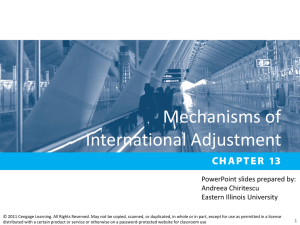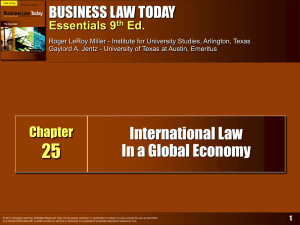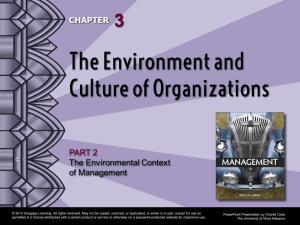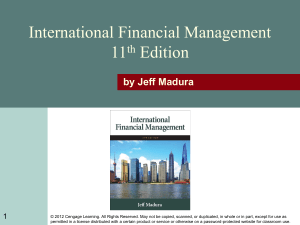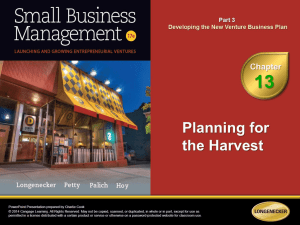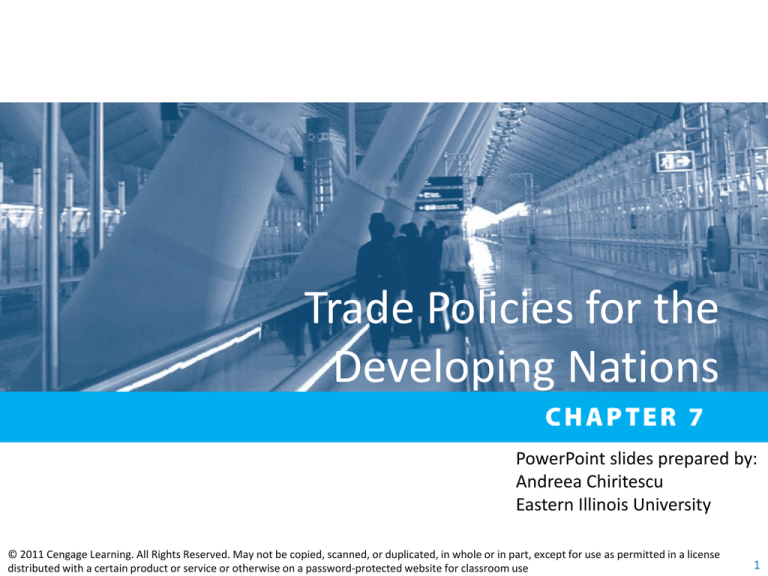
Trade Policies for the
Developing Nations
PowerPoint slides prepared by:
Andreea Chiritescu
Eastern Illinois University
© 2011 Cengage Learning. All Rights Reserved. May not be copied, scanned, or duplicated, in whole or in part, except for use as permitted in a license
distributed with a certain product or service or otherwise on a password‐protected website for classroom use
1
Developing Nations
• By real income
• Advanced nations
• North America, Western Europe, Australia, New
Zealand, and Japan
• High levels of gross domestic product per capita
• Longer life expectancies
• Higher levels of adult literacy
• Developing nations
• Africa, Asia, Latin America, and the Middle East
© 2011 Cengage Learning. All Rights Reserved. May not be copied, scanned, or duplicated, in whole or in part, except for use as permitted in a license
distributed with a certain product or service or otherwise on a password‐protected website for classroom use
2
TABLE 7.1 Basic economic and social indicators for selected
nations, 2007
© 2011 Cengage Learning. All Rights Reserved. May not be copied, scanned, or duplicated, in whole or in part, except for use as permitted in a license
distributed with a certain product or service or otherwise on a password‐protected website for classroom use
3
Developing-Nation Trade Characteristics
• Characteristics of developing-nation trade
•
•
•
•
Highly dependent on advanced nations
Exports go to the advanced nations
Imports originate in advanced nations
Trade among developing nations - relatively
minor
© 2011 Cengage Learning. All Rights Reserved. May not be copied, scanned, or duplicated, in whole or in part, except for use as permitted in a license
distributed with a certain product or service or otherwise on a password‐protected website for classroom use
4
Developing-Nation Trade Characteristics
• Composition of developing-nations’ exports
• Primary products
• Agricultural goods, raw materials, and fuels
• Manufactured goods
• Textiles
• Labor intensive
• Modest amounts of technology in their production
© 2011 Cengage Learning. All Rights Reserved. May not be copied, scanned, or duplicated, in whole or in part, except for use as permitted in a license
distributed with a certain product or service or otherwise on a password‐protected website for classroom use
5
TABLE 7.2
Structure of output for selected advanced
nations and developing nations, 2007
© 2011 Cengage Learning. All Rights Reserved. May not be copied, scanned, or duplicated, in whole or in part, except for use as permitted in a license
distributed with a certain product or service or otherwise on a password‐protected website for classroom use
6
Developing-Nation Trade Characteristics
• Developing nations – moving into exports of
manufactured products
• Investment in people and factories
• Higher educational levels
• Higher capital stock per worker
• Improvements in transport and
communications
• Reforms
• Liberalization of trade barriers
© 2011 Cengage Learning. All Rights Reserved. May not be copied, scanned, or duplicated, in whole or in part, except for use as permitted in a license
distributed with a certain product or service or otherwise on a password‐protected website for classroom use
7
Tensions Between Developing and
Advanced Nations
• Poor nation – to develop
• Need to take advantage of international trade
• Problem: advanced world – increased barriers
to imports from these developing nations
• Other problems:
• Structural weaknesses
• Nonexistent or inadequate institutions and policies
• Law and order, sustainable macroeconomic
management, and public services
© 2011 Cengage Learning. All Rights Reserved. May not be copied, scanned, or duplicated, in whole or in part, except for use as permitted in a license
distributed with a certain product or service or otherwise on a password‐protected website for classroom use
8
Trade Problems of the Developing Nations
• Unstable export markets
• Exports - concentrated in only one or a few
primary products
• Instability of prices and producer revenues
• Low price elasticity of the demand and supply
schedules
© 2011 Cengage Learning. All Rights Reserved. May not be copied, scanned, or duplicated, in whole or in part, except for use as permitted in a license
distributed with a certain product or service or otherwise on a password‐protected website for classroom use
9
TABLE 7.3 Developing nation dependence on primary
products, 2007
© 2011 Cengage Learning. All Rights Reserved. May not be copied, scanned, or duplicated, in whole or in part, except for use as permitted in a license
distributed with a certain product or service or otherwise on a password‐protected website for classroom use
10
FIGURE 7.1
Export price instability for a developing nation
When the supply of a commodity is highly price-inelastic, decreases (or increases) in demand
will generate wide variations in price. When the demand for a commodity is highly priceinelastic, increases (or decreases) in supply will generate wide variations in price.
© 2011 Cengage Learning. All Rights Reserved. May not be copied, scanned, or duplicated, in whole or in part, except for use as permitted in a license
distributed with a certain product or service or otherwise on a password‐protected website for classroom use
11
Trade Problems of the Developing Nations
• Worsening terms of trade
• Prices of their exports relative to their imports
have fallen
• Import – manufactured goods
• Monopoly market
• Gains in productivity = higher earnings
• Export – primary goods
• Competitive market
• Gains in productivity = lower prices
© 2011 Cengage Learning. All Rights Reserved. May not be copied, scanned, or duplicated, in whole or in part, except for use as permitted in a license
distributed with a certain product or service or otherwise on a password‐protected website for classroom use
12
TRADE
CONFLICTS
Falling commodity prices threaten
growth of exporting nations
• 2000-2010, increasing commodity prices
• Favorable growing conditions
• Benefited producers and governments in many
developing nations
• Higher prices; Rising profits
• Increasing tax revenues
• Latin America - economic growth, 5% per year
during 2003–2008
• Previous 30 years: 3.5%
© 2011 Cengage Learning. All Rights Reserved. May not be copied, scanned, or duplicated, in whole or in part, except for use as permitted in a license
distributed with a certain product or service or otherwise on a password‐protected website for classroom use
13
TRADE
CONFLICTS
Falling commodity prices threaten
growth of exporting nations
• Recession 2008 – 2009
• Advanced economies shrank
• Lower demand for commodities
• Developing nations
• Lower commodity prices; Export revenues declined
• Cut back production; Layoffs
• Advanced nations - economic downturns
• Quickly transmitted to their developing-nation
trading partners
© 2011 Cengage Learning. All Rights Reserved. May not be copied, scanned, or duplicated, in whole or in part, except for use as permitted in a license
distributed with a certain product or service or otherwise on a password‐protected website for classroom use
14
Trade Problems of the Developing Nations
• Worsening terms of trade
• Prices they pay for imports
• Rise faster than the prices commanded by their
exports
• As income rises
• People tend to spend more on manufactured goods
than primary goods
© 2011 Cengage Learning. All Rights Reserved. May not be copied, scanned, or duplicated, in whole or in part, except for use as permitted in a license
distributed with a certain product or service or otherwise on a password‐protected website for classroom use
15
Trade Problems of the Developing Nations
• Limited market access
• Global protectionism
• Agriculture
• Labor-intensive manufactured products
• Higher tariffs
• Major trading blocks: EU, NAFTA
• Tariff escalation
• By developed and developing nations
• Quotas on imports
© 2011 Cengage Learning. All Rights Reserved. May not be copied, scanned, or duplicated, in whole or in part, except for use as permitted in a license
distributed with a certain product or service or otherwise on a password‐protected website for classroom use
16
FIGURE 7.2
Trade barriers limit export opportunities of
developing nations (a)
They Face High Tariff Walls, Especially in Agricultural Commodities and Labor-Intensive Manufacturers
© 2011 Cengage Learning. All Rights Reserved. May not be copied, scanned, or duplicated, in whole or in part, except for use as permitted in a license
distributed with a certain product or service or otherwise on a password‐protected website for classroom use
17
FIGURE 7.2
Trade barriers limit export opportunities of
developing nations (b)
They Face High Tariff Walls, Especially in Agricultural Commodities and Labor-Intensive Manufacturers
© 2011 Cengage Learning. All Rights Reserved. May not be copied, scanned, or duplicated, in whole or in part, except for use as permitted in a license
distributed with a certain product or service or otherwise on a password‐protected website for classroom use
18
TABLE 7.4
Tariffs of selected developing nations and
advanced nations
© 2011 Cengage Learning. All Rights Reserved. May not be copied, scanned, or duplicated, in whole or in part, except for use as permitted in a license
distributed with a certain product or service or otherwise on a password‐protected website for classroom use
19
Trade Problems of the Developing Nations
• Agricultural export subsidies of advanced
nations
• Discourage agricultural imports
• Displace developing-nation shipments to
advanced-nation markets
• Result in unwanted surpluses
• Often dumped onto world markets
• Decreasing prices for many agricultural
commodities
• Reduces the revenues of developing nations
© 2011 Cengage Learning. All Rights Reserved. May not be copied, scanned, or duplicated, in whole or in part, except for use as permitted in a license
distributed with a certain product or service or otherwise on a password‐protected website for classroom use
20
Trade Problems of the Developing Nations
• American food-aid policies
• U.S. food donated to the developing world
• Saved millions of lives
• Purchases surplus grain from American farmers
(by law)
• Instead of purchasing what foreigners grow
• Supports American farmers, processors, and
shippers, and the world’s hungry
© 2011 Cengage Learning. All Rights Reserved. May not be copied, scanned, or duplicated, in whole or in part, except for use as permitted in a license
distributed with a certain product or service or otherwise on a password‐protected website for classroom use
21
Stabilizing Primary-Product Prices
• International commodity agreements (ICAs).
• Among developing nations
• Attempt to stabilize export prices and revenues
of primary products
• Agreements between leading producing and
consuming nations of commodities
• Stabilizing prices
• Assuring adequate supplies to consumers
• Promoting economic development of producers
© 2011 Cengage Learning. All Rights Reserved. May not be copied, scanned, or duplicated, in whole or in part, except for use as permitted in a license
distributed with a certain product or service or otherwise on a password‐protected website for classroom use
22
Stabilizing Primary-Product Prices
• International commodity agreements (ICAs)
• Promote stability in commodity markets
• Production and export controls
• Buffer stocks
• Multilateral contracts
© 2011 Cengage Learning. All Rights Reserved. May not be copied, scanned, or duplicated, in whole or in part, except for use as permitted in a license
distributed with a certain product or service or otherwise on a password‐protected website for classroom use
23
Stabilizing Primary-Product Prices
• Production and export controls
• Affect the price - influence world supply
• Based on a target price
• Obstacles:
• Distribution of the limits among producing nations
• Entrance of new producers
• Producers have the incentive to cheat on output
restrictions
• Enforcement is difficult
© 2011 Cengage Learning. All Rights Reserved. May not be copied, scanned, or duplicated, in whole or in part, except for use as permitted in a license
distributed with a certain product or service or otherwise on a password‐protected website for classroom use
24
Stabilizing Primary-Product Prices
• Buffer stock
• A producers’ association (international agency)
• Prepared to buy and sell a commodity in large
amounts
• Supplies of a commodity
• Financed and held by the producers’ association
• Buffer stock manager
• Buys from the market when prices are falling
• Sells from the buffer stock when prices are high
© 2011 Cengage Learning. All Rights Reserved. May not be copied, scanned, or duplicated, in whole or in part, except for use as permitted in a license
distributed with a certain product or service or otherwise on a password‐protected website for classroom use
25
FIGURE 7.3
Buffer stock: price ceiling and price support
During periods of rising tin demand, the buffer-stock manager sells tin to prevent the price from rising above
the ceiling level. However, prolonged defense of the ceiling price may result in depletion of the tin stockpile,
which undermines the effectiveness of this price-stabilization tool and leads to an upward revision of the
ceiling price. During periods of abundant tin supplies, the manager purchases tin to prevent the price from
falling below the floor level. Again, prolonged defense of the price floor may exhaust the funds to purchase
excess supplies of tin at the floor price and may lead to a downward revision of the floor price.
© 2011 Cengage Learning. All Rights Reserved. May not be copied, scanned, or duplicated, in whole or in part, except for use as permitted in a license
distributed with a certain product or service or otherwise on a password‐protected website for classroom use
26
Stabilizing Primary-Product Prices
• Buffer stock advantages
• Can promote economic efficiency
• Can moderate the price inflation of the
industrialized nations
• Buffer stock – problems
• Agreeing on a target price
• High costs of holding the stocks
• Poor decisions
© 2011 Cengage Learning. All Rights Reserved. May not be copied, scanned, or duplicated, in whole or in part, except for use as permitted in a license
distributed with a certain product or service or otherwise on a password‐protected website for classroom use
27
Stabilizing Primary-Product Prices
• Multilateral contracts
• To hold the price within a target range
• Minimum price at which importers will purchase
guaranteed quantities
• Maximum price at which producing nations will sell
guaranteed amounts to the importers
• Advantage
• Less distortion of the market mechanism and the
allocation of resources
• Tend to furnish only limited market stability
© 2011 Cengage Learning. All Rights Reserved. May not be copied, scanned, or duplicated, in whole or in part, except for use as permitted in a license
distributed with a certain product or service or otherwise on a password‐protected website for classroom use
28
Stabilizing Primary-Product Prices
• Fair-trade coffee movement
• Objective: to increase the income of poor
farmers in developing nations
• Farmers can sell their beans directly to roasters and
retailers ($1.26 per pound)
• Bypassing the traditional practice of selling to
middlemen in their own nations ($0.40 per pound)
© 2011 Cengage Learning. All Rights Reserved. May not be copied, scanned, or duplicated, in whole or in part, except for use as permitted in a license
distributed with a certain product or service or otherwise on a password‐protected website for classroom use
29
Stabilizing Primary-Product Prices
• Fair-trade coffee movement
• Farmers organize in cooperatives
• As many as 2,500 members
• Set prices
• Arrange for export directly to brokerage firms and
other distributors
• 500,000 of the developing world’s 4 million
coffee farmers
© 2011 Cengage Learning. All Rights Reserved. May not be copied, scanned, or duplicated, in whole or in part, except for use as permitted in a license
distributed with a certain product or service or otherwise on a password‐protected website for classroom use
30
Stabilizing Primary-Product Prices
• Fair-trade coffee movement
• Biggest winners
• Not the farmers
• Retailers
• Charge huge markups on fair-traded coffee
• Promote themselves as corporate citizens
• Can get away with it - consumers generally are given
little or no information about how much of a product’s
price goes to farmers
© 2011 Cengage Learning. All Rights Reserved. May not be copied, scanned, or duplicated, in whole or in part, except for use as permitted in a license
distributed with a certain product or service or otherwise on a password‐protected website for classroom use
31
The OPEC Oil Cartel
• Organization of Petroleum Exporting Nations
(OPEC)
• Group of nations that sells petroleum on the
world market
• Attempt to support higher prices
• Than under more competitive conditions
• To maximize member-nation profits
• 1973 - 1974, $3 to $12 per barrel
• 1979 - 1981, $36 per barrel
© 2011 Cengage Learning. All Rights Reserved. May not be copied, scanned, or duplicated, in whole or in part, except for use as permitted in a license
distributed with a certain product or service or otherwise on a password‐protected website for classroom use
32
The OPEC Oil Cartel
• OPEC
• Strong and inelastic demand for oil
• Control of about half of world oil production
and two-thirds of world oil reserves
• 1986, $11 per barrel
• World recession
• Falling demand
• 2007, $98 per barrel
• Soaring demand
• Tight supply
© 2011 Cengage Learning. All Rights Reserved. May not be copied, scanned, or duplicated, in whole or in part, except for use as permitted in a license
distributed with a certain product or service or otherwise on a password‐protected website for classroom use
33
The OPEC Oil Cartel
• Maximizing cartel profits
• Behaving like a profit-maximizing monopolist
• Restrict output and drive up price
• Problems with cartels:
• Incentive to cheat
• Large number of sellers
• Cost and demand differences
• Potential competition
• Economic downturn
• Substitute goods
© 2011 Cengage Learning. All Rights Reserved. May not be copied, scanned, or duplicated, in whole or in part, except for use as permitted in a license
distributed with a certain product or service or otherwise on a password‐protected website for classroom use
34
FIGURE 7.4
Maximizing OPEC profits
As a cartel, OPEC can increase the price of oil from $20 to $30 per barrel by assigning
production quotas to its members. The quotas decrease output from 1,500 to 1,000 barrels
per day and permit producers that were pricing oil at average cost to realize a profit. Each
producer has the incentive to increase output beyond its assigned quota, to the point at
which the OPEC price equals marginal cost. But if all producers increase output in this
manner, there will be a surplus of oil at the cartel price, forcing the price of oil back to $20
per barrel.
© 2011 Cengage Learning. All Rights Reserved. May not be copied, scanned, or duplicated, in whole or in part, except for use as permitted in a license
distributed with a certain product or service or otherwise on a password‐protected website for classroom use
35
The OPEC Oil Cartel
• OPEC as a Cartel
• A secretariat, a conference of ministers, a
board of governors, an economic commission
• Currently controls < 40% of world supply
• Insufficient amount to establish an effective cartel
• Actual production higher than its target levels
• Too many member nations produce more than
their assigned quotas
© 2011 Cengage Learning. All Rights Reserved. May not be copied, scanned, or duplicated, in whole or in part, except for use as permitted in a license
distributed with a certain product or service or otherwise on a password‐protected website for classroom use
36
The OPEC Oil Cartel
• To offset the market power of OPEC
• Importing nations need policies to increase the
supply and/or decrease demand
• Raising the fuel economy standards mandated by
the federal government
• Resistance from auto producers
• Increasing the federal excise tax on gasoline
• Harm low-income consumers
© 2011 Cengage Learning. All Rights Reserved. May not be copied, scanned, or duplicated, in whole or in part, except for use as permitted in a license
distributed with a certain product or service or otherwise on a password‐protected website for classroom use
37
The OPEC Oil Cartel
• To offset the market power of OPEC
• Allowing oil companies to drill on federal land
designated as wilderness in Alaska
• What if the wilderness is destroyed?
• Diversifying oil imports
• Work more closely with unsavory regimes (Angola,
Indonesia, and Vietnam)
• Developing alternate sources of energy such as
biofuels and wind power
• Require governmental subsidies financed by taxpayers
© 2011 Cengage Learning. All Rights Reserved. May not be copied, scanned, or duplicated, in whole or in part, except for use as permitted in a license
distributed with a certain product or service or otherwise on a password‐protected website for classroom use
38
TRADE
CONFLICTS
Are international labor standards
needed to prevent social dumping?
• Labor unions and human rights activists
• Fear that advanced-nation wages and benefits
• Forced down by unfair competition
• From nations with much lower labor costs
• “Social dumping”
• Market access to advanced nations should be
conditional
• Raising labor standards in developing nations to
prevent a “race to the bottom” in wages and
benefits (“social clause” )
© 2011 Cengage Learning. All Rights Reserved. May not be copied, scanned, or duplicated, in whole or in part, except for use as permitted in a license
distributed with a certain product or service or otherwise on a password‐protected website for classroom use
39
TRADE
CONFLICTS
Are international labor standards
needed to prevent social dumping?
• International harmonization of labor standards
• Economic argument
• Low wages and labor standards in developing
nations threaten the living standards of workers in
developed nations
• Moral argument
• Low wages and labor standards violate the human
rights of workers in developing nations
© 2011 Cengage Learning. All Rights Reserved. May not be copied, scanned, or duplicated, in whole or in part, except for use as permitted in a license
distributed with a certain product or service or otherwise on a password‐protected website for classroom use
40
TRADE
CONFLICTS
Are international labor standards
needed to prevent social dumping?
• Concerns
• Developing nations
• Suspicious of protectionism
• What constitutes fairness?
• Abundance of cheap labor in China?
• Plentiful coconut trees in the Philippines?
• Most advanced-nation labor standards
• Not feasible for many developing nations
© 2011 Cengage Learning. All Rights Reserved. May not be copied, scanned, or duplicated, in whole or in part, except for use as permitted in a license
distributed with a certain product or service or otherwise on a password‐protected website for classroom use
41
Aiding the Developing Nations
• Institutions and policies created to support
developing nations
• World Bank
• International Monetary Fund
• Generalized system of preferences
© 2011 Cengage Learning. All Rights Reserved. May not be copied, scanned, or duplicated, in whole or in part, except for use as permitted in a license
distributed with a certain product or service or otherwise on a password‐protected website for classroom use
42
Aiding the Developing Nations
• United Nations monetary & financial conference
• Bretton Woods, New Hampshire, July 1944
• World Bank, International Monetary Fund
• To ease the transition from a wartime to a
peacetime environment
• To help prevent a recurrence of the turbulent
economic conditions of the Great Depression era
• Sources of funds to promote economic
development and financial stability
© 2011 Cengage Learning. All Rights Reserved. May not be copied, scanned, or duplicated, in whole or in part, except for use as permitted in a license
distributed with a certain product or service or otherwise on a password‐protected website for classroom use
43
Aiding the Developing Nations
• World Bank
•
•
•
•
International organization
Loans to developing nations
Poverty reduction and economic development
185 member nations
• Jointly responsible for how the institution is
financed and how its money is spent
• Problem: fraud and corruption in developing
countries
© 2011 Cengage Learning. All Rights Reserved. May not be copied, scanned, or duplicated, in whole or in part, except for use as permitted in a license
distributed with a certain product or service or otherwise on a password‐protected website for classroom use
44
Aiding the Developing Nations
• World Bank Group
• International Bank for Reconstruction and
Development
• International Development Association
• International Finance Corporation
• Multilateral Investment Guarantee Agency
• International Center for Settlement of
Investment Disputes
© 2011 Cengage Learning. All Rights Reserved. May not be copied, scanned, or duplicated, in whole or in part, except for use as permitted in a license
distributed with a certain product or service or otherwise on a password‐protected website for classroom use
45
TABLE 7.5
World Bank lending by sector, 2008
(millions of dollars)
© 2011 Cengage Learning. All Rights Reserved. May not be copied, scanned, or duplicated, in whole or in part, except for use as permitted in a license
distributed with a certain product or service or otherwise on a password‐protected website for classroom use
46
Aiding the Developing Nations
• International Monetary Fund (IMF)
• 185 nations
• A bank for the central banks of member
nations
• Funds come from
• Quotas (subscriptions)
• Pooled funds of member nations
• Loans
• Loans to member nations- conditional
© 2011 Cengage Learning. All Rights Reserved. May not be copied, scanned, or duplicated, in whole or in part, except for use as permitted in a license
distributed with a certain product or service or otherwise on a password‐protected website for classroom use
47
Aiding the Developing Nations
• Critics of the IMF
• Bailouts may contribute to the moral-hazard
problem
• Restrictive monetary and fiscal policy
conditions - contractionary effect
• Generalized system of preferences (GSP)
• Nonreciprocal tariff preferences to exports of
developing nations
• Attempts to promote economic development in
developing nations through increased trade
© 2011 Cengage Learning. All Rights Reserved. May not be copied, scanned, or duplicated, in whole or in part, except for use as permitted in a license
distributed with a certain product or service or otherwise on a password‐protected website for classroom use
48
Aiding the Developing Nations
• Factors that erode GSP effectiveness
• Preferences
• Apply to products that already face relatively low
tariffs
• Tariff preferences
• Eroded by nontariff measures
• Products and nations
• Removed from GSP eligibility because of lobbying
by domestic interest groups in importing nations
© 2011 Cengage Learning. All Rights Reserved. May not be copied, scanned, or duplicated, in whole or in part, except for use as permitted in a license
distributed with a certain product or service or otherwise on a password‐protected website for classroom use
49
Aiding the Developing Nations
• Critics of aid programs
• Aid:
• Fostered government bureaucracies
• Prolonged bad governments
• Favored the wealthy in poor nations
• Been squandered
• 40 years of aid – still widespread poverty
• Aid programs
• Substantially altered, drastically cut, or eliminated
altogether
© 2011 Cengage Learning. All Rights Reserved. May not be copied, scanned, or duplicated, in whole or in part, except for use as permitted in a license
distributed with a certain product or service or otherwise on a password‐protected website for classroom use
50
Aiding the Developing Nations
• Proponents of aid programs
• Aid
• Enhanced poverty reduction
• Enhanced growth in some nations
• Prevented worse performance in other nations
• Shortcomings of aid
• Have more to do with donors than beneficiaries
© 2011 Cengage Learning. All Rights Reserved. May not be copied, scanned, or duplicated, in whole or in part, except for use as permitted in a license
distributed with a certain product or service or otherwise on a password‐protected website for classroom use
51
Aiding the Developing Nations
• Aid for the development of infrastructure
• Transportation systems, communications,
energy generation, and banking services
• Relatively strong effects on economic growth
• Growth-oriented aid
• Aid for disaster and humanitarian relief
• Food supply, water sanitation
• Less immediate effects on economic growth
© 2011 Cengage Learning. All Rights Reserved. May not be copied, scanned, or duplicated, in whole or in part, except for use as permitted in a license
distributed with a certain product or service or otherwise on a password‐protected website for classroom use
52
Economic Growth Strategies
• Import substitution
• Extensive use of trade barriers
• To protect domestic industries from import
competition
• Inward-oriented
• Trade and industrial incentives favor production for
the domestic market over the export market
© 2011 Cengage Learning. All Rights Reserved. May not be copied, scanned, or duplicated, in whole or in part, except for use as permitted in a license
distributed with a certain product or service or otherwise on a password‐protected website for classroom use
53
Economic Growth Strategies
• Advantages of import substitution
• Low risks of establishing a home industry to
replace imports
• Easier for a developing nation to protect its
manufacturers against foreign competitors
• Than to force advanced nations to reduce their
trade restrictions
• Foreigners have an incentive to locate
manufacturing plants in the nation
© 2011 Cengage Learning. All Rights Reserved. May not be copied, scanned, or duplicated, in whole or in part, except for use as permitted in a license
distributed with a certain product or service or otherwise on a password‐protected website for classroom use
54
Economic Growth Strategies
• Disadvantages of import substitution
• Domestic industries
• No incentive to increase their efficiency
• Manufacturers cannot take advantage of
economies of scale
• Discriminates against all other producers
• Including potential exporting ones
• Very difficult to remove the restrictions
• Breeds corruption
© 2011 Cengage Learning. All Rights Reserved. May not be copied, scanned, or duplicated, in whole or in part, except for use as permitted in a license
distributed with a certain product or service or otherwise on a password‐protected website for classroom use
55
Economic Growth Strategies
• Export-led growth
• Export-oriented policy
• Outward oriented - links the domestic economy
to the world economy
• Promote growth through the export of
manufactured goods
• Trade controls - nonexistent or very low
• Industrialization
• Natural outcome of development
© 2011 Cengage Learning. All Rights Reserved. May not be copied, scanned, or duplicated, in whole or in part, except for use as permitted in a license
distributed with a certain product or service or otherwise on a password‐protected website for classroom use
56
Economic Growth Strategies
• Advantages of export-oriented policies
• Encourage industries in which developing
nations are likely to have a comparative
advantage
• Allow domestic manufacturers greater scope
for exploiting economies of scale
• Impose a competitive discipline on domestic
firms that forces them to increase efficiency
© 2011 Cengage Learning. All Rights Reserved. May not be copied, scanned, or duplicated, in whole or in part, except for use as permitted in a license
distributed with a certain product or service or otherwise on a password‐protected website for classroom use
57
FIGURE 7.5
Openness and economic growth
During the 1980s and 1990s, developing nations that were more open to the international
economy grew faster than those remaining more closed.
© 2011 Cengage Learning. All Rights Reserved. May not be copied, scanned, or duplicated, in whole or in part, except for use as permitted in a license
distributed with a certain product or service or otherwise on a password‐protected website for classroom use
58
Economic Growth Strategies
• Economic growth is good for the poor
• Developing nations with continuing growth
• Significant progress in decreasing poverty
• Liberal economic policies
• Open markets and monetary and fiscal stability
• Raise the incomes of the poor and everyone else in
society proportionately
© 2011 Cengage Learning. All Rights Reserved. May not be copied, scanned, or duplicated, in whole or in part, except for use as permitted in a license
distributed with a certain product or service or otherwise on a password‐protected website for classroom use
59
East Asian Economies
• Economic success
• Highly diverse in natural resources,
populations, cultures, and economic policies
• High rates of investment
• High and increasing endowments of human
capital due to universal primary and secondary
education
© 2011 Cengage Learning. All Rights Reserved. May not be copied, scanned, or duplicated, in whole or in part, except for use as permitted in a license
distributed with a certain product or service or otherwise on a password‐protected website for classroom use
60
TABLE 7.6
East Asian economies’ growth rates, 2006–2008
© 2011 Cengage Learning. All Rights Reserved. May not be copied, scanned, or duplicated, in whole or in part, except for use as permitted in a license
distributed with a certain product or service or otherwise on a password‐protected website for classroom use
61
East Asian Economies
• Foster competitiveness
• Invested in people
• Provided a favorable competitive climate for
private enterprise
• Economies - open to international trade
• Actively sought foreign technology
• Discouraged the organization of trade unions
• Free and competitive labor markets
• No minimum wage legislation
© 2011 Cengage Learning. All Rights Reserved. May not be copied, scanned, or duplicated, in whole or in part, except for use as permitted in a license
distributed with a certain product or service or otherwise on a password‐protected website for classroom use
62
East Asian Economies
• Post-world War II era
• Trade policies: import substitution
• Late 1950s and 1960s
• Export-push strategies
• Problems
• Major pollution problems
• Whopping trade surpluses
• Protectionist sentiment overseas
© 2011 Cengage Learning. All Rights Reserved. May not be copied, scanned, or duplicated, in whole or in part, except for use as permitted in a license
distributed with a certain product or service or otherwise on a password‐protected website for classroom use
63
East Asian Economies
• Flying-geese pattern of economic growth
• Nations gradually move up in technological
development
• By following in the pattern of nations ahead of
them in the development process
• Result of market forces
© 2011 Cengage Learning. All Rights Reserved. May not be copied, scanned, or duplicated, in whole or in part, except for use as permitted in a license
distributed with a certain product or service or otherwise on a password‐protected website for classroom use
64
China’s Transformation to Capitalism
• 1970s
• Value of exports and imports
• Less than $15 billion
• 30th largest exporting nation
• Negligible participant in world financial markets
• 2005
• World’s second largest economy
• National output
• Over half that of the U.S.
• 60% larger than Japan’s
© 2011 Cengage Learning. All Rights Reserved. May not be copied, scanned, or duplicated, in whole or in part, except for use as permitted in a license
distributed with a certain product or service or otherwise on a password‐protected website for classroom use
65
China’s Transformation to Capitalism
• Since 1970s, China’s “marketizing” its economy
• Small, step-by-step changes
• Agriculture and industry
• Increase the role of the producing unit
• Increase individual incentives
• Reduce the role of state planners
• Market-determined prices
© 2011 Cengage Learning. All Rights Reserved. May not be copied, scanned, or duplicated, in whole or in part, except for use as permitted in a license
distributed with a certain product or service or otherwise on a password‐protected website for classroom use
66
China’s Transformation to Capitalism
• Since 1970s, China’s “marketizing” its economy
• Greater competition
• Open to foreign investment and joint ventures
• Economic zones - firms could keep foreign
exchange earnings and hire and fire workers
• Open to international trade
© 2011 Cengage Learning. All Rights Reserved. May not be copied, scanned, or duplicated, in whole or in part, except for use as permitted in a license
distributed with a certain product or service or otherwise on a password‐protected website for classroom use
67
China’s Transformation to Capitalism
• Reforms still needed addressing
• Massive restructuring of state-owned
industries
• Cleanup of bankrupt state banks
• Creation of a social security system
• Establishment of a monetary system with a
central bank free of Communist Party or
government control
© 2011 Cengage Learning. All Rights Reserved. May not be copied, scanned, or duplicated, in whole or in part, except for use as permitted in a license
distributed with a certain product or service or otherwise on a password‐protected website for classroom use
68
China’s Transformation to Capitalism
• Concerns
• Product safety
• Quality of the environment
• Labor protections
© 2011 Cengage Learning. All Rights Reserved. May not be copied, scanned, or duplicated, in whole or in part, except for use as permitted in a license
distributed with a certain product or service or otherwise on a password‐protected website for classroom use
69
TRADE
CONFLICTS
Does foreign direct investment hinder
or help economic development?
• Foreign direct investment
• Foreign firms
• Locate production plants in the domestic economy
• Acquire a substantial ownership position in a
domestic firm
• Restricted because of
• Nationalist sentiment
• Concerns - foreign economic and political influence
• Fear of exploitation
• Resources of the host nation
© 2011 Cengage Learning. All Rights Reserved. May not be copied, scanned, or duplicated, in whole or in part, except for use as permitted in a license
distributed with a certain product or service or otherwise on a password‐protected website for classroom use
70
TRADE
CONFLICTS
Does foreign direct investment hinder
or help economic development?
• Foreign direct investment
• May encourage economic growth
• Increase in the stock of capital
• Higher productivity of labor
• Higher incomes
• Transfer of technological knowledge
• Can be restricted in a given industry for
national security purposes
• Deterioration in the global environment
© 2011 Cengage Learning. All Rights Reserved. May not be copied, scanned, or duplicated, in whole or in part, except for use as permitted in a license
distributed with a certain product or service or otherwise on a password‐protected website for classroom use
71
India: Breaking Out of the Third World
• Rapidly improved economic performance
• Freer trade policies
• Economy of India
• Agriculture, handicrafts, manufacturing,
services
• Two-thirds of the Indian workforce –
agriculture
• Services - growing sector
© 2011 Cengage Learning. All Rights Reserved. May not be copied, scanned, or duplicated, in whole or in part, except for use as permitted in a license
distributed with a certain product or service or otherwise on a password‐protected website for classroom use
72
India: Breaking Out of the Third World
• India’s abundant factor
• Relatively well-educated, English-speaking
labor
• 1947
• Socialism
• Import-substitution model
• Isolated from the mainstream world until 1980s
© 2011 Cengage Learning. All Rights Reserved. May not be copied, scanned, or duplicated, in whole or in part, except for use as permitted in a license
distributed with a certain product or service or otherwise on a password‐protected website for classroom use
73
India: Breaking Out of the Third World
• 1991 - Market-based economy
• Encourages foreign investment
• Draws more wealth from industry and services
• Dramatic increase in economic growth and
falling poverty rates
© 2011 Cengage Learning. All Rights Reserved. May not be copied, scanned, or duplicated, in whole or in part, except for use as permitted in a license
distributed with a certain product or service or otherwise on a password‐protected website for classroom use
74
India: Breaking Out of the Third World
• Dynamic growth
• Outsourcing and automobile industries
• Most of its economy
• Restrictions on trade and foreign investment
• Stifle competition and foster the survival of
inefficient firms
© 2011 Cengage Learning. All Rights Reserved. May not be copied, scanned, or duplicated, in whole or in part, except for use as permitted in a license
distributed with a certain product or service or otherwise on a password‐protected website for classroom use
75
India: Breaking Out of the Third World
• Issues to sustain robust economic growth
• Improvement in infrastructure
• Roads, electric power generation, rail freight, and
ports
• High rate of population growth
• Major advantage - almost limitless labor supply and
consumer demand
• Necessity of investing in education and health care
• Creating adequate opportunities for employment
© 2011 Cengage Learning. All Rights Reserved. May not be copied, scanned, or duplicated, in whole or in part, except for use as permitted in a license
distributed with a certain product or service or otherwise on a password‐protected website for classroom use
76
India: Breaking Out of the Third World
• Further efforts needed
• Systematically deregulate sectors
• Retailing, the news media, and banking
• Eliminate preferences for small-scale,
inefficient producers
• Repeal legislation blocking layoffs in mediumand large-sized firms
• Reform its agriculture industry in order to
generate jobs in rural areas
© 2011 Cengage Learning. All Rights Reserved. May not be copied, scanned, or duplicated, in whole or in part, except for use as permitted in a license
distributed with a certain product or service or otherwise on a password‐protected website for classroom use
77


